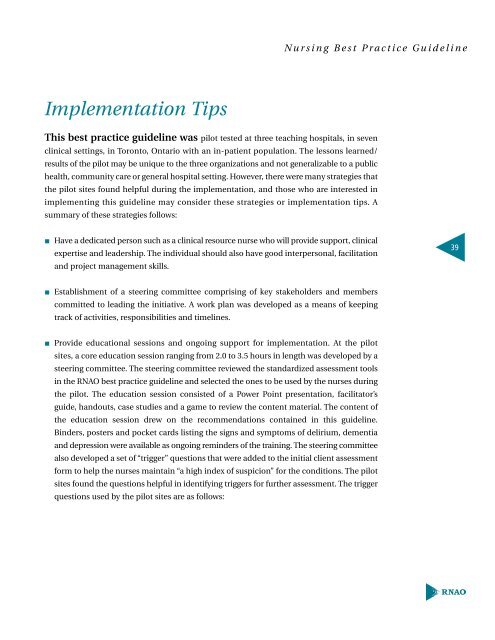Screening for Delirium, Dementia and Depression in Older Adults
Screening for Delirium, Dementia and Depression in Older Adults
Screening for Delirium, Dementia and Depression in Older Adults
- No tags were found...
Create successful ePaper yourself
Turn your PDF publications into a flip-book with our unique Google optimized e-Paper software.
Nurs<strong>in</strong>g Best Practice Guidel<strong>in</strong>eImplementation TipsThis best practice guidel<strong>in</strong>e was pilot tested at three teach<strong>in</strong>g hospitals, <strong>in</strong> sevencl<strong>in</strong>ical sett<strong>in</strong>gs, <strong>in</strong> Toronto, Ontario with an <strong>in</strong>-patient population. The lessons learned/results of the pilot may be unique to the three organizations <strong>and</strong> not generalizable to a publichealth, community care or general hospital sett<strong>in</strong>g. However, there were many strategies thatthe pilot sites found helpful dur<strong>in</strong>g the implementation, <strong>and</strong> those who are <strong>in</strong>terested <strong>in</strong>implement<strong>in</strong>g this guidel<strong>in</strong>e may consider these strategies or implementation tips. Asummary of these strategies follows: Have a dedicated person such as a cl<strong>in</strong>ical resource nurse who will provide support, cl<strong>in</strong>icalexpertise <strong>and</strong> leadership. The <strong>in</strong>dividual should also have good <strong>in</strong>terpersonal, facilitation<strong>and</strong> project management skills.39 Establishment of a steer<strong>in</strong>g committee compris<strong>in</strong>g of key stakeholders <strong>and</strong> memberscommitted to lead<strong>in</strong>g the <strong>in</strong>itiative. A work plan was developed as a means of keep<strong>in</strong>gtrack of activities, responsibilities <strong>and</strong> timel<strong>in</strong>es. Provide educational sessions <strong>and</strong> ongo<strong>in</strong>g support <strong>for</strong> implementation. At the pilotsites, a core education session rang<strong>in</strong>g from 2.0 to 3.5 hours <strong>in</strong> length was developed by asteer<strong>in</strong>g committee. The steer<strong>in</strong>g committee reviewed the st<strong>and</strong>ardized assessment tools<strong>in</strong> the RNAO best practice guidel<strong>in</strong>e <strong>and</strong> selected the ones to be used by the nurses dur<strong>in</strong>gthe pilot. The education session consisted of a Power Po<strong>in</strong>t presentation, facilitator’sguide, h<strong>and</strong>outs, case studies <strong>and</strong> a game to review the content material. The content ofthe education session drew on the recommendations conta<strong>in</strong>ed <strong>in</strong> this guidel<strong>in</strong>e.B<strong>in</strong>ders, posters <strong>and</strong> pocket cards list<strong>in</strong>g the signs <strong>and</strong> symptoms of delirium, dementia<strong>and</strong> depression were available as ongo<strong>in</strong>g rem<strong>in</strong>ders of the tra<strong>in</strong><strong>in</strong>g. The steer<strong>in</strong>g committeealso developed a set of “trigger” questions that were added to the <strong>in</strong>itial client assessment<strong>for</strong>m to help the nurses ma<strong>in</strong>ta<strong>in</strong> “a high <strong>in</strong>dex of suspicion” <strong>for</strong> the conditions. The pilotsites found the questions helpful <strong>in</strong> identify<strong>in</strong>g triggers <strong>for</strong> further assessment. The triggerquestions used by the pilot sites are as follows:
















